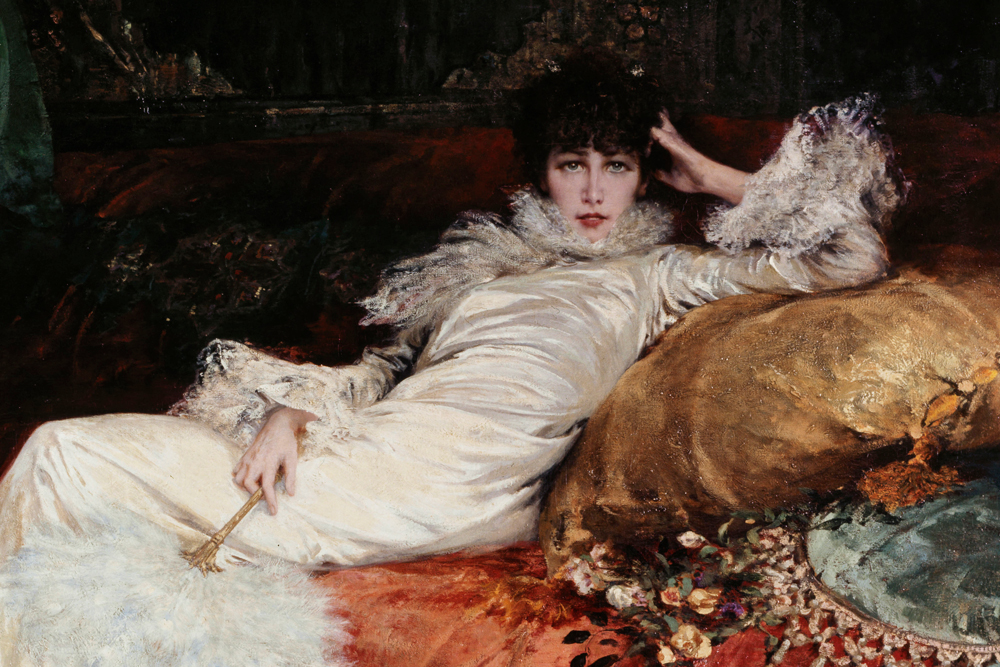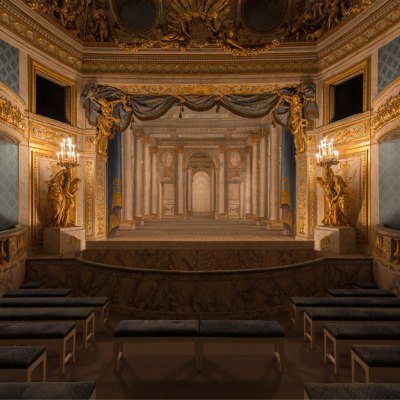‘The queen of attitude and the princess of gestures’ is how playwright Edmond Rostand characterised the French actress Sarah Bernhardt (1844–1923). She was also known as ‘La Divine’ and ‘the golden voice’. To mark the centenary of her death, the Petit Palais in Paris is staging a spectacular exhibition about the life and times of Bernhardt, casting her as the embodiment of fin-de-siècle Paris. It contains 400 objects, including paintings, posters, stage costumes and photographs, many of which have been coaxed out of private collections to be shown publicly for the first time.
Sarah Bernhardt as Cleopatra (1891), Napoléon Sarony. Photo: © RMN-Grand Palais (musée d’Orsay)/Hervé Lewandowski
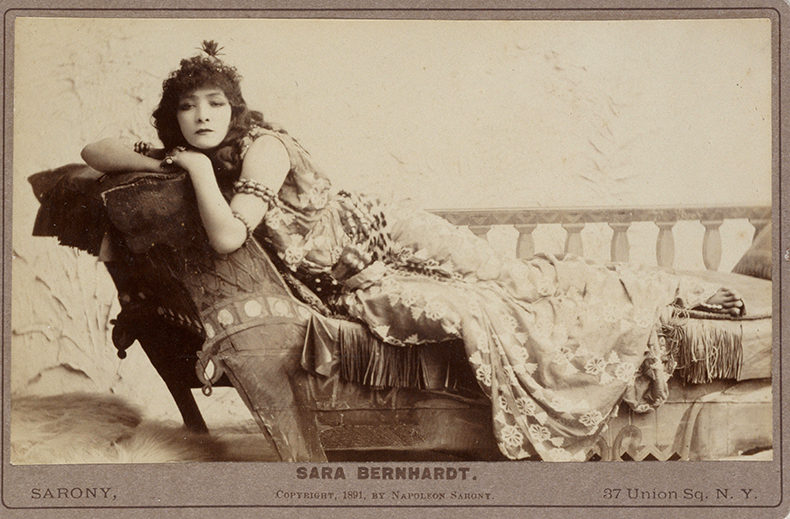
The exhibition journeys from Bernhardt’s demi-monde and theatrical beginnings as a young woman to her silent movie performances in the 1910s, focusing along the way on the richness and variety of her artistic circle, her well-publicised taste for the macabre, her greatest theatrical roles, her railway tours around America and her political commitments. Atmospheric scenography – deep, muted colours on the walls; shifts between darker, more intimate spaces and oases of light – makes for an evocative experience of the period. There are opportunities to hear the sound of Bernhardt’s voice; ever a fan of technical innovations, the actress had herself recorded at Edison’s studios while she was in America.
Crown worn by Bernhardt in Victorien Sardou’s Theodora (1884). Photo: © Paris Museums/Palais Galliéra-Fashion Museum of Paris
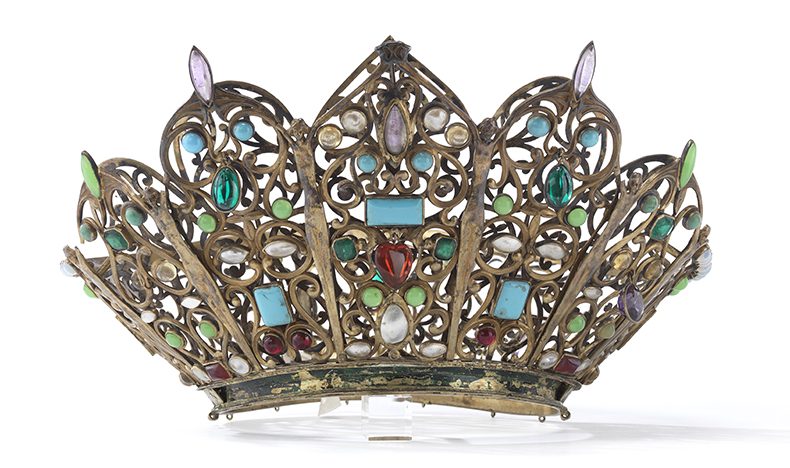
The exhibition’s tagline is ‘Et la femme créa la star’: ‘And the woman created the star’. To be sure, Bernhardt crafted her own glittering image with great attention to detail. The actress recruited the illustrator Alphonse Mucha to create her hieratic theatrical posters, with their tall, elegant format and curvaceous Art Nouveau motifs. Carefully staged photographs of her on- and off-stage (but always in character as ‘Sarah Bernhardt’) were widely available to her fans. Loans of sumptuous accessories from the Palais Galliéra Musée de la Mode illustrate her status here as a fashion icon. Bernhardt let it be known that she liked to learn her lines – or nap – while lying in a coffin lined with white satin. She kept wild animals as pets; her alligator died of drinking too much champagne. The global nature of her fame and omnipresence of her image – notably in advertising, where she lent her name to face powder, ‘health-giving absinthe’ and even tinned sardines – marks her as a precursor of Hollywood-style stardom. One of several witty interactive elements of the show is the Instagram account @sarahbernhardtofficiel, whose posts are written in Bernhardt’s grande-dame ‘voice’.
Lorenzaccio (1899), Alphonse Mucha. Photo: © Paris Musées/Musée Carnavalet – Histoire de Paris
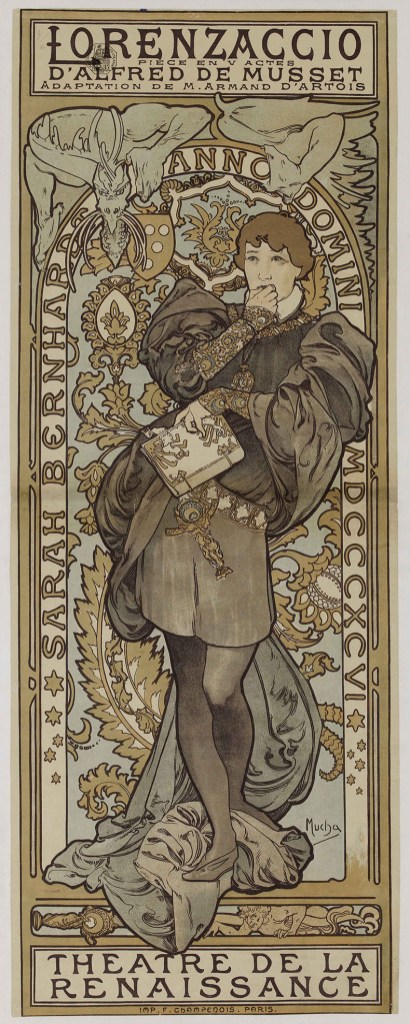
Bernhardt approached the theatre with an impressive degree of integrity. She showed an exacting interest in all aspects of the productions in which she starred: smearing velvet with saffron to achieve the right visual texture, or ensuring the historical accuracy of Byzantine mosaics. This is explored in the ‘gallery of great roles’, with its long row of wondrous stage costumes that the actress wore as Joan of Arc, Cleopatra, Phaedra or the Empress Theodora, as well as exquisite models of theatrical sets. In her book L’Art du théâtre (1923), Bernhardt reflected on diction, inflexion and gesture, and explained her interest in playing male roles. She was not the only actress of her era to do so, but she took it exceptionally seriously as a means of expanding her stage craft and appropriating richer, more complex characters – for instance, by playing the part of Hamlet in French before an English audience at Stratford-upon-Avon in 1899. This was made easier by her slender figure – an unfashionable look for women at the time, which inspired caricatures depicting her as a skeleton or a stick of salsify. One of her last great successes on the stage in 1900 was with the historical drama L’Aiglon, in which, at the age of 56, she played a young man of twenty – the son of Napoleon I – in a daringly close-fitting white military uniform. This was the inaugural performance at Bernhardt’s eponymous theatre, where she went on to produce plays for 20 years. It is now the Théâtre de la Ville near the Châtelet.
Algae (1900), Sarah Bernhardt. Photo: © Galerie Talabardon & Gautier, Paris/Seven Square
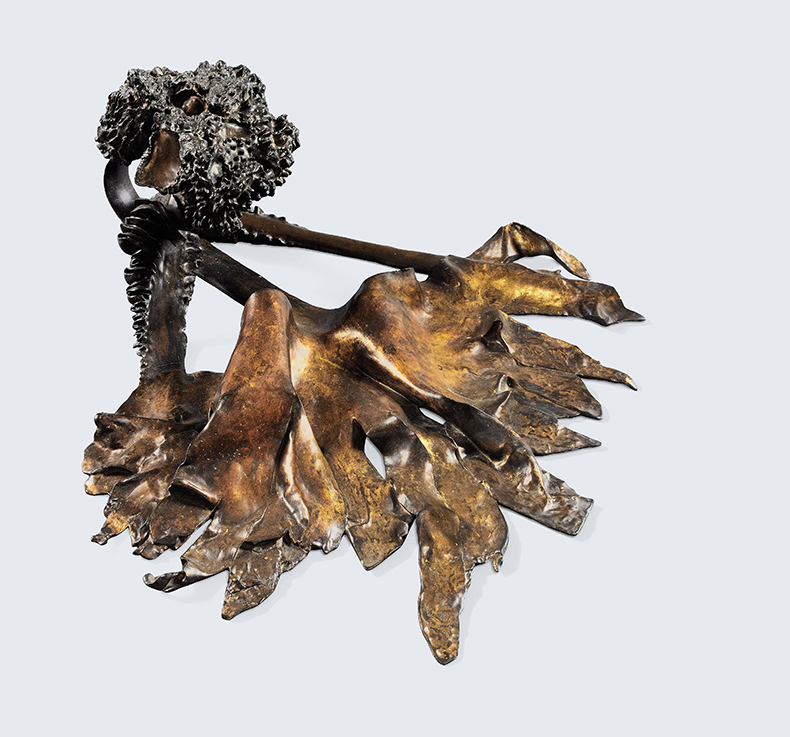
Still, the greatest revelation of the show is staged in the conservatory of the Petit Palais. Here, Sarah Bernhardt’s circle of artistic friends – especially the painters Georges Clérin and Louise Abbéma – is evoked, but the displays also reveal Bernhardt’s talent as an artist in her own right. Her sculptures – many of which have recently been rediscovered – include some lively bust portraits of artist friends, a remarkable and rather macabre funerary portrait of her husband Jacques Damala (on loan from the Metropolitan Museum of Art in New York) whose disembodied head is shown lying sideways on a bed of roses and poppies, and (unsurprisingly) some self-portraits, including one of Bernhardt as a winged chimera holding out a skull. In the final room, a particularly uncanny series of sculptures is displayed: bronze casts of large pieces of seaweed Bernhardt collected on the beaches of Belle-Île in Brittany, which she showed at the 1900 Exposition Universelle. These reflect Art Nouveau’s taste for the sea, while also foreshadowing Salvador Dalí’s (or even David Cronenberg’s) fervid imaginings.
In 1915, Bernhardt’s right leg was amputated due to an acute form of tuberculosis but she continued to act until her death in 1923. Her personal motto was ‘Quand même’: ‘Nevertheless.’
Portrait of Sarah Bernhardt (1876), Georges Clairin. Photo: © Paris Musées/Petit Palais

‘Sarah Bernhardt: And the Woman Created the Star’ is at the Petit Palais, Paris, until 27 August.
